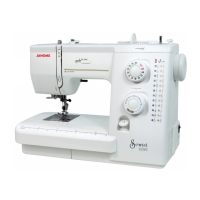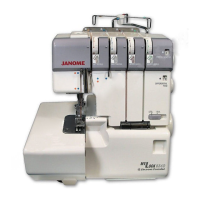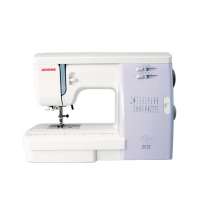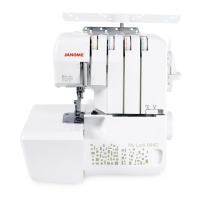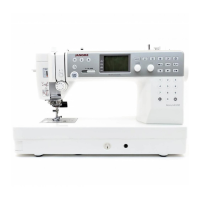Troubleshooting
Condition
Cause
Reference
The fabric is not
1.
The feed dog is packed with lint. See page 42.
being fed
2. The presser foot has been raised.
Lower the presser foot.
smoothly.
3 .. Pressure of the foot is too weak. See page 9
The
needle
1. The needle is incorrectly inserted.
See page
8.
breaks.
2.
The needle is bent or blunt. See page
8.
3. The fabric is forcedly pulled.
Pull
the fabric lightly.
The thread
1.
The machine is not correctly threaded.
See pages 16 - 25, 30 and 32.
breaks.
2. The
needle or looper thread tension is too tight. See pages
28-29,
31,
33-34.
3. The needle is incorrectly inserted. See page
8.
4.
The needle is bent
or
blunt.
See
page
8.
Skipped stitches
1.
The needle is bent or blunt.
See
page
8.
2. The machine is not correctly threaded.
See pages
16
- 25, 30 and 32.
3. The
needle is incorrectly inserted.
See page 18.
The seam is not
1. The
needle and/or looper thread tensions are
See pages 28-29, 31,
33-34
sewn neatly.
not correctly adjusted.
2.
The machine is not correctly threaded.
See pages 16 - 25, 30 and 32.
3.
The needle and/or the thread are not suitable
for the fabric being sewn.
See pages 35 and 39.
4. The thread is not
betwe.en
the tension discs. See pages 18,
21,
22 and 25.
Seam puckering.
1 . The
needle or looper thread tension is too tight.
See pages
28-29,
31,
33-34.
2.
The machine is not correctly threaded.
See pages 16 - 25, 30 and 32.
3.
The differential feed dial is not correctly
adjusted.
See page 10.
The machine
1.
The machine has not been plugged in firmly. See page 5.
does
2.
The power switch is turned off. See page
5.
not operate.
The fabric is not 1. The position of the upper knife is not adjusted
See page 41.
cut
neatly. properly.
2.
The upper knife is dull. Replace the upper knife.
(See page 41.)
44

